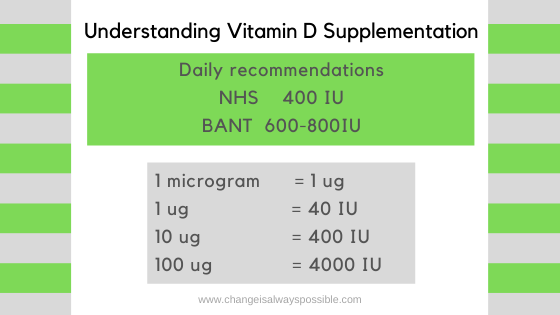This blog includes a guest post Vitamin D & Nutrition by Moira Newiss, a Registered Nutritional Therapy Practitioner. It takes approximately 6 mins to read in total.
Updated on 3rd January 2021 : Video included at the bottom of the post which includes vital Vitamin D from several experts.
![]()
“Something so simple-vitamin D supplementation-could improve the health stats of millions and so becomes an elegant solution to many of our health problems today.”
Carol L Wagner MD
My Story
“I don’t test anymore, because everyone I used to test was deficient,” said my nutritionist. So started my relationship with Vitamin D.
After an initial high dose I was put on a permanent maintenance supplement. This helped me to reach an adequate level according to my NHS blood test. A second nutritionist said the same thing and continued my programme as neither of them considered adequate, adequate. They were looking for optimal to support my recovery from chronic illness. I got there.
Only if the doctor says so
Ever since then I have encouraged friends and family to consider supplementing often to no avail, sadly. Some people will only do things if the doctor says so. This is despite the fact that doctors training on nutrition is scant. Nutritional therapists, on the other hand train for at least 3 years focusing only on nutrition.
Tried in vain
Two years ago I tried to get a Vitamin D test done for a family member who lives in a care home. After meeting constant resistance from both the care home and the doctor’s surgery I gave up. Since discovering more about Vitamin D, Covid and the current NHS advice I decided to make a second attempt.
This person is currently extremely vulnerable. They have at least 3 of the underlying health conditions related to Covid-19 deaths. In my book anything that might help them has got to be a good idea.
Without cause
I recently received this answer to my request that he be tested. “The GP has informed us that they do not routinely give Vitamin D or B12 without cause.”
Sigh! Honestly I get weary of it all sometimes. My interactions with the medical profession often leave me flabbergasted. How simple it would have been to explain a little more.
NHS Advice
It seems tests are very limited nowadays and having done some research I think I know why. It’s a pity the GP couldn’t have been more helpful and directed me to the Public Health Scotland guidance, Vitamin D and You which states:
Research shows that many people in Scotland have low vitamin D levels. Groups who are at greater risk of vitamin D deficiency should take a daily supplement. They include:
- All babies and young children from birth to 4 years. Babies who are fed infant formula will not need vitamin drops unless they are drinking less than 500 ml of formula milk a day, as these products are fortified with vitamin D.
- Pregnant and breastfeeding women.
- People who are not exposed to much sunlight, including those who are housebound or stay indoors for long periods, those in an institution such as a care home, and those who cover their skin for cultural reasons.
- People who have darker skin and therefore need to spend longer in the sun to produce vitamin D.
Those in need
So before we even consider the current Covid situation certain groups are in need of Vitamin D. Those in Care Homes and with darker skin especially. Interestingly both happen to make up a substantial number of those in the high Covid fatality groups. In my book that is a “cause” to test as it would aide decisions regarding supplementation.
All in need
However, they are no longer alone, we are all in need now. According to a NICE review of Vitamin D ,
“UK Government advice during the pandemic is that everyone should consider taking 10 micrograms of vitamin D a day to keep bones and muscles healthy because they might not be getting enough vitamin D from sunlight if they are indoors most of the day.”
Did you know that?

The research is now mounting that shows a link between Covid outcomes and Vitamin D. Those with lowest levels of Vitamin D have the worst outcomes.
It’s a no brainer
What I’d very much like to know is why, given NHS guidance, the Government has not made it very clear to all of us; we should be supplementing? It’s a no brainer! In fact they could even fund it, how about that?
Scots Need Vitamin D
A retired GP felt so strongly about Vit D for the Scottish population she has created the Scots Need Vitamin D website to help us all learn more. She believes passionately in the positive health impacts of good Vitamin D levels.
Understanding Vitamin D
Ok I’ve had my Vitamin D say, what is probably much more important is understanding Vitamin D in practice. To this end I’d like to thank Moira Newiss a Registered Nutritional Therapy Practitioner for kindly providing the following guide to Vitamin D and Nutrition. A printable copy of her guide is available here. It contains a list of references for those of you who like to do your own research.
Vitamin D & Nutrition by Moira Newiss
Why Does Our Body Need Vitamin D?
Vitamin D is produced in our skin by the interaction of the UVB part of sunlight which produces a compound that is converted to Vitamin D in our liver and turned into an activated form when needed. There are many ways by which Vitamin D can improve our health and help reduce the risk of infection and death. In relation to respiratory infections this is through its effect on physical barriers in our body (such as our lung and gut linings) and via our immune system.
Unfortunately in Scotland we don’t get enough sunlight between October and March to make vitamin D and as a result we need to rely on our stored supply of it. Of course how much we have and how long it lasts depends on several things, including how much sun exposure you have had, how well you produce it and how fast your body uses it up.
What Natural Food Sources Contain Vitamin D?
From October to March, we need to rely on dietary sources of vitamin D and since it is found only in a small number of foods, it can be difficult to get enough. Good food sources of vitamin D3 are oily fish and eggs. Other food sources include fortified foods such as breakfast cereals and spreads.
For examples of some of the top vitamin D containing foods, 140g of grilled mackerel will contain roughly 11.9µg vitamin D, 140g baked salmon has 10.2µg and two scrambled eggs will have 3.4µg. For vegans some mushrooms contain vitamin D2 but this depends on how much exposure to light they have had.
If We Supplement How Should We Do This?
Because of the difficulty getting sufficient from food the Scottish Government now recommends that everyone (including children) should consider taking a daily supplement containing 10 micrograms of vitamin D, particularly during the winter months (October – March). They also specifically recommend that groups at higher risk of vitamin D deficiency take a daily supplement all year round. Adults and children aged 5 years and over who are at risk of vitamin D deficiency should take 10 ug of vitamin D every day.
Supplements are available at your local health food shop, chemist or some supermarkets. Vitamin D supplements may state the amount in micrograms or international units. To help you work this out 1 microgram of vitamin D is the same as 40 international units so 10µg equates to 400 international units.
Within the context of COVID-19 and the apparent second wave, the British Association of Applied Nutrition & Lifestyle Medicine recommends all adults supplement a minimum of 600-800 IU/d vitamin D3 daily, increasing to a higher therapeutic dose of 5000 IU/d should symptoms develop. Research into respiratory infections shows that Vitamin D helps prevent flu and cold symptoms developing into acute respiratory infections, lowers the severity of infection and reduces ICU admissions.
Checking Your Vitamin D Level
Most of the population of the west coast of Scotland have below optimal levels of Vitamin D due to the low level of sun exposure. Current NHS Guidance suggests that most people do not require to have their Vitamin D levels tested if they are taking less than 5,000 units a day, as toxicity is unlikely at these levels.
However if you want to ensure your vitamin D levels are optimal you can arrange a test yourself directly through a company such as Medichecks who offer finger prick testing services by post. If you are seeing a Nutritional Therapist they will be able to advise you on how best to optimise your levels should you be found to have deficient or sub-optimal levels by adjusting the dose of vitamin D.
Vitamin D levels of <25nmol/L are generally considered to be deficient and levels over 50nmol/L are considered sufficient, while optimum levels are thought to be>75nmol/L.
Radical Self Care
Some of the Radical Self Care ideas I write about can feel challenging. They may need effort or require us to challenge or confront beliefs and behaviours. However we also need to care for ourselves in very practical ways too. Our resilience to illness very much depends on our level of vitality. Vitality depends to a large extent on how we are caring for our physical bodies.
Therefore I think we can safely say that increasing your Vitamin D levels is a very simple and easy first step on the Radical Self Care path.
“Sometimes the simple things are the best things.”
Anon
Disclaimer: The views expressed here, in blog posts and on the website Change Is Always Possible are those of the author Mairi Stones alone, and do not represent the views of any associated bodies. We do not diagnose, treat, prevent or cure any disease or condition. Information provided in this blog is not intended to substitute advice, treatment and/or diagnosis from qualified medical and nutritional professionals.




[…] last blog Understanding Vitamin D offered a very simple non radical self care practice which could be helpful right now. This […]